Commentary for Bern Riddle 2: De lucerna
NEVILLEMOGFORD
Date: Fri 18 Dec 2020Matching Riddle: Bern Riddle 2: De lucerna
In the last riddle, we met a rather unusual pot. Now, we get to meet the pot’s equally unusual half-sister—the lamp.
The first rule of medieval studies is: 'You do not talk about “The Dark Ages.”' The second rule of medieval studies is: 'You do not talk about “The Dark Ages.”' This is because the term suggests that the Middle Ages were a time of great ignorance or mystery—and, for the most part, they weren’t!
But, for the sake of an awful joke, I am going to break all the rules. So, I will introduce this commentary by saying: “If you're living in the Dark Ages, you’re going to need a good lamp.”
There is some truth to this. In early medieval Europe, candles and oil lamps were an important source of illumination for all kinds of people, from night-watchmen to manuscript-reading nuns, and they held great cultural and religious significance too. So, it should come as no surprise that riddles were written about them. One early riddler, Symphosius, wrote a lantern riddle (Symphosius Riddle 67). Another, Aldhelm of Malmesbury, wrote a riddle on the candle (Aldhelm Riddle 52).
Like many other Bern riddles, we are expected to guess the identity if the speaker’s mother and father. The obvious choice for a father is fire (ignis), whose flickering form is different to the shining appearance of the lamp. The “old mother” (vetus mater) is a bit trickier. She could be heat (calor) or a candle (candela) from which it is lit, since both of which are grammatically feminine. Another possibility is the olive (oliva) from which the fuel is made. The “seed” (germen) from which the lamp is formed is probably the “spark” (scintilla) from which it is lit.
Line 4 tells us that the flame comes from an “open mouth” (patulo… ore). This would strongly suggest an oil lamp, which burns its fuel using a wick, which sticks out of a hole in the lamp’s body.
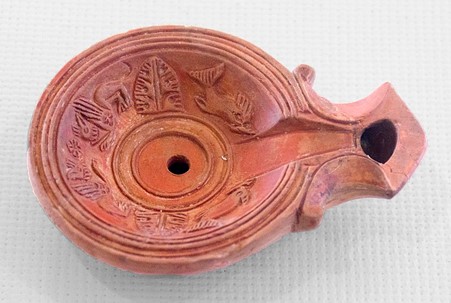
Roman oil lamp from the Museu Nacional Arqueològic de Tarragona.
Photo (by Ángel M. Felicísimo) from Wikimedia Commons (licence: CC BY-SA 2.0)
Line 5 explains that the lamp is useless if it gets extinguished by the wind or rain. To protext their flames from the elements, lamps were sometimes housed in storm-lanterns constructed from glass or thin, scraped animal horn. Isidore of Seville mentions glass lanterns in his 7th century encyclopedia, The Etymologies (page 402). Similarly, Alfred the Great’s bibliographer, Asser, tells an elaborate story of how Alfred is said to have ordered a special lantern to be made of wood and ox-horn, since his candle-clock kept on being blown out by the wind (Keynes and Lapidge, page 108). Alfred was certainly not the first person to think of this—horn lamps were used from antiquity. The oldest example in Britain was discovered in the summer of 2010, when a metal detector enthusiast found a bronze Roman lamp in a field near Sunbury, Suffolk. Originally, this lantern would have been surrounded by a thin layer of scraped horn.
But why am I talking about storm-lanterns here? After all, they are conspicuously absent in Bern Riddle 2. Well, the lamp is trying to draw our attention to another riddle, Bern Riddle 59. This riddle depicts the moon as if it were a lantern, protected by a special “shell” (testudo). The shell protects it from “rain, snow, frost, ice, and lightning” (imber, nix, pruina, glacies… fulgora) (line 5). When we read the two riddles together, we see that the moon—which is unaffected by the weather—is a better source of light than the lamp is!
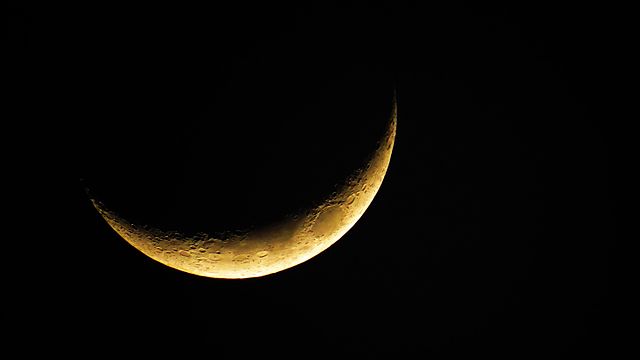
Crescent or “horned” moon. Photo (by Nirupam Sarker) from Wikimedia Commons (licence: CC BY-SA 4.0)
It gets even more complicated when you realise that this is also a response to another riddle, Symphosius Riddle 67, which depicts a lantern as if it were the moon. The conceit is that the lantern is made of horn and the moon is “horned.” We will return to this riddle in the commentary for Bern Riddle 59.
The final line of Bern Riddle 2 is also speaking to yet another riddle. It calls the lamp a ‘friend of light’ (amica lucis). This phrase is also used (in a very different way) to describe the papyrus in Bern Riddle 27. Papyrus was a common wicking material in lamps—filling the hole of line 4.
So, there we have it! Riddle 2 starts off with the puzzle of the lamp’s parentage, and it ends with a series of intertextual puzzles. And this is one of the fascinating things about medieval riddles—they are always whispering to each other. And if we listen carefully, we can hear them chatter.
References and Suggested Reading:
Isidore of Seville. The Etymologies of Isidore of Seville. Edited by Stephen A. Barney, W. J. Lewis, J. A. Beach and Oliver Berghof. Cambridge: Cambridge University Press, 2006.
Keynes, Simon and Lapidge, Michael, eds. and trans. Alfred the Great: Asser's Life of King Alfred and Other Contemporary Sources. Harmondsworth: Penguin, 1983.
Mogford, Neville. “The Moon and Stars in the Bern and Eusebius Riddles” in Riddles at Work in the Early Medieval Tradition: Words, Ideas, Interactions. Edited by Megan Cavell and Jennifer Neville. Manchester: Manchester University Press, 2020.
Symphosius, “Riddle 67” in The Aenigmata: An introduction, Text, and Commentary. Edited by T. J. Leary (London: Bloomsbury, 2014), pages 47 & 183-4.
Tags: latin Bern Riddles
Related Posts:
Bern Riddle 2: De lucerna
Bern Riddle 58: De luna

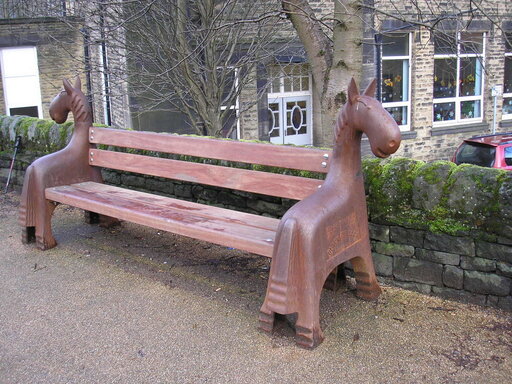
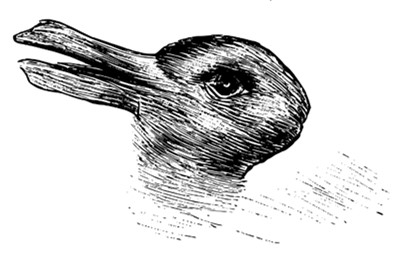
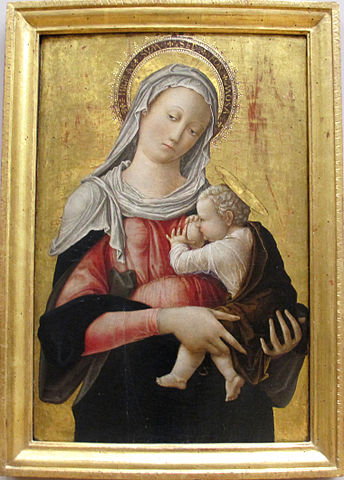
Commentary for Bern Riddle 1: De olla
NEVILLEMOGFORD
Date: Fri 11 Dec 2020Matching Riddle: Bern Riddle 1: De olla
Storms! Philosophy! God! Heaven! Humankind! These are some of the suitably epic subjects that other medieval riddle collections begin with. The first of the Bern riddles, on the other hand, is all about the humble clay pot. But this does not mean that Bern Riddle 1 is mundane. In fact, it is quite the opposite—it describes an ordinary object in very unexpected and fantastical ways.
Pottery is one of the oldest and most important human technologies. Once you learn that clay hardens when baked at high temperatures, you can create all kinds of lovely things—bowls, flasks and jugs, as well as lamps, weights and figurines, and bricks and tiles. Oh, and pots!
Before I start on the riddle, here’s a very brief potted history… of pottery.
Early medieval pottery is incredibly diverse, and it varies greatly by region and time, depending on the material, design, and technologies involved. For example, in England, pottery from the 6th and 7th centuries was typically made on a small scale, shaped by hand, and fired on bonfires. The pottery wheel was introduced by the 9th century and production became more specialised. By the 10th century, a lot of pottery was produced in towns, often using techniques such as wheel-throwing and large, chimneyed kilns.
In Lombardy, where some scholars think the Bern riddles were written, the situation was more complex still, but the general pattern was the same. The turbulent 7th century brought a general decline in quality, but wheels continued to be used in many places, and the pottery industry expanded again from the 800s onwards alongside the newly expanding cities.
Anyway, enough history—let’s get back to the riddle! As with most of the Bern riddles, it is written from the perspective of the object—a technique known as prosopopoeia. The pot riddle is the first of eleven riddles on domestic subjects, and the riddle-creator may have been influenced by chapter XX of Isidore of Seville’s very influential, 7th century encyclopedia, The Etymologies (Salvador-Bello, pages 257-8). On a less scholarly note, when I think of these riddles, I immediately think of the anthropomorphic Mrs Potts, Lumiere and co. in Disney’s Beauty and the Beast. Prosopopoeia is still very relevant in our culture today.
Lines 1 and 2 are all about the material of the pot. They challenge us to explain how a daughter can have two fathers, one immortal and the other mortal. Some readers will know that Latin has three genders—masculine, feminine, and neuter. In these riddles, the grammatical gender of the solution is often depicted in terms of human gender identity. For example, the Latin for pot (olla) is feminine, and so the pot becomes a daughter (nata) rather than a son (natus). The same is true about the fathers. The father who dies is probably fire (ignis) and the father who endures is probably clay (limus)—both words are grammatically masculine. Alternatively, Thomas Klein has argued that the father who dies is the maker of the pot and the father who lives is fire or heat (Klein, pages 407-8).
Lines 3 and 4 explain how the clay is softened, shaped and spun. The single word giro (literally “in a circle”) tells us that the riddler was familiar with pottery wheels—which would fit nicely with the idea that the Bern riddles were written in Italy. The mother in line three could be the hand (manus) that kneads the clay or the water that softens it (aqua). This depends on how we understand the word dura (“hard”), which can refer to either the mother or the child.
Just like the Exeter Book riddles, the Bern riddles sometimes use innuendo. Line 3 tells us that a soft thing is twisted into a “suitable form.” This reminds me of the stiþes nathwæt (“something stiff”) of Exeter Riddle 54. It also makes Bern Riddle 1 a medieval precursor to the sexy pottery scene in the popular 1990s film Ghost .
The final two lines refer to the firing of the pot in a kiln or open fire (“when warmed”), which is needed before it can feed people. The riddle then closes with the offer of food to everyone. Thanks, pot—don’t mind if I do!
Bern Riddle 1 is the perfect introduction to the Bern riddles. It contains many of the themes and motifs that we find elsewhere in the collection: children and parents, life and death, feeding and food-giving, the body, and opposites. And, just like the other riddles, it still captures our imagination today, through its uncanny knack of making ordinary objects seem extraordinary and wondrous.
References and Suggested Reading:
On early medieval pottery
Hamerow, Helena. “Pottery.” In The Wiley Blackwell Encyclopedia of Anglo-Saxon England. Edited by Michael Lapidge, John Blair, Simon Keynes, and Donald Scragg, Second Edition. Chichester: Whiley-Blackwell, 2014. pages 381-3
Wickham, Chris. Framing the Early Middle Ages: Europe and the Mediterranean, 400-800. Oxford: Oxford University Press, 2005. pages 728-741
On the riddle
Klein, Thomas. “Pater Occultus: The Latin Bern Riddles and Their Place in Early Medieval Riddling.” Neophilologus 103 (2019), pages 339-417.
Röösli, Samuel. “The Pot, the Broom, and Other Humans: Concealing Material Objects in the Bern Riddles.” In Secrecy and Surveillance in Medieval and Early Modern England. Edited by Annette Kern-Stähler & Nicole Nyffenegger. Swiss Papers in English Language and Literature (SPELL), Vol. 37 (Tübingen: Gunter Narr Verlag, 2020), pages 87-104.
Winferfeld, Paul. “Observationes criticalae.” Philologus vol. 53 (1899), pages 289-95.
Tags: latin Bern Riddles
Related Posts:
Commentary for Exeter Riddle 54
Bern Riddle 1: De olla